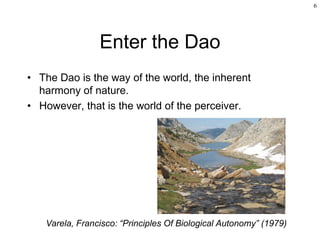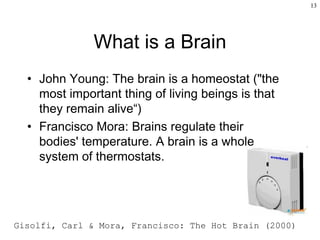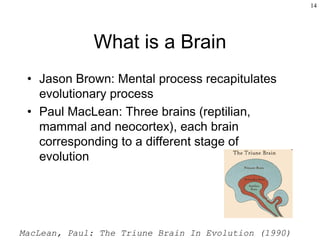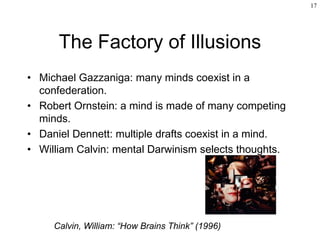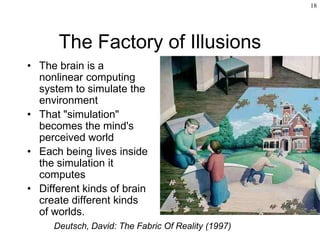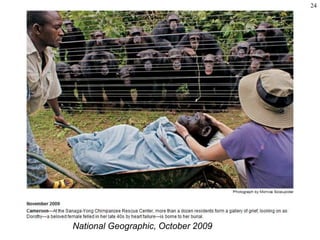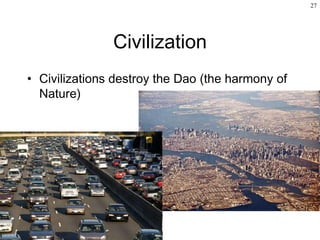What is the dao of an ant
- 1. 1 What is the Dao of an Ant A collage of Cognitive Science 25 slides Piero Scaruffi 2009 www.scaruffi.com “Trfg# fd%hsk er@et wn*nnf” (loose transliteration of a traditional ant adage)
- 2. 2 Piero Scaruffi • Cultural Historian • Cognitive Scientist • Software Designer • Poet • www.scaruffi.com
- 3. 3 Enter the Perceiver • The world is always and only perceived. • Neither the tree nor the forest exist if no conscious being is perceiving them • “Matter” without a conscious perceiver “is” only a shapeless, colorless, soundless amalgam of particles, waves, fields... • It is the perceiver who creates the world of trees, forests and sounds. Berkeley, George: "The Principles of Human Knowledge" (1710)
- 4. 4 Enter the Perceiver • We carefully separate the human mind from Nature, but Nature is an illusion of the human mind and the human mind is a product of Nature. • Both Relativity and Quantum Physics assign a key role to the observer: reality is relative to the observer, and the observer creates it. • The world of a perceiver is the world that the perceiver’s mind created John Von Neumann: “Mathematical Foundations Of Quantum Mechanics” (1932)
- 5. 5 Enter the Perceiver • The interaction of organisms with their environment is about picking up information from the environment. • Perceiving is actually "recognizing", which in turn is the essence of reasoning, which in turn entails action. • They (perceiving, reasoning, acting) are all facets of the same process, which is, ultimately, living. Gibson, James-Jerome : “The Ecological Approach To Visual Perception” (1979)
- 6. 6 Enter the Dao • The Dao is the way of the world, the inherent harmony of nature. • However, that is the world of the perceiver. Varela, Francisco: “Principles Of Biological Autonomy” (1979)
- 7. 7 What is a Living Being • Brains are, first and foremost, alive • Many definitions of life: reproduction, metabolism, evolution… • Richard Dawkins: living beings have to work to keep from eventually merging into their surroundings Dawkins, Richard: "The Blind Watchmaker" (1987) • The identity of a living being is defined by a “membrane”: self/non- self boundary • Extended phenotype
- 8. 8 What is a Living Being • Biological systems are about the flow and transduction of energy • Ecosystems are networks of energy flows • Organization emerges spontaneously whenever energy flows • Life is the property of an ecological system, not of a single isolated organism • Equilibrium is death Morowitz, Harold: "Energy Flow In Biology" (1968)
- 9. 9 What is a Living Being • The identity of a living being is defined by its interaction with the environment: input and output • Feedback Wiener, Norbert: "Cybernetics" (1948)
- 10. 10 What is a Living Being • Representation – No representation: pure behaviorism impossible because there must be a translation from the format/energy of the sensory input to the format/energy of the motor output – Linear representation: the “knowledge-based” approach (rules, frames, networks) – Nonlinear representation: neural nets Searle John: "The Rediscovery Of The Mind" (1992)
- 11. 11 What is a Thinking Being • Nonlinear Representation (Simulation) – A key property of life is the ability to predict the future – World situations are described by non-linear systems – The dynamics of nonlinear systems is such that it is virtually impossible to predict their behavior other than by simulating it – Simulation has to be very fast in order to be useful – The nervous system is precisely such a tool to perform fast simulations of nonlinear systems – Plausible reasoning (not precise logic) Fox, Ronald: "Energy And The Evolution Of Life" (1988)
- 12. 12 What is a Thinking Being • Nonlinear Representation (Simulation) – Note: The simulation of a non-linear world produces a largely linear world (the everyday world of objects) that obeys the linear laws of common sense Kuipers, Benjamin: “Qualitative Reasoning” (1994)
- 13. 13 What is a Brain • John Young: The brain is a homeostat ("the most important thing of living beings is that they remain alive“) • Francisco Mora: Brains regulate their bodies' temperature. A brain is a whole system of thermostats. Gisolfi, Carl & Mora, Francisco: The Hot Brain (2000)
- 14. 14 What is a Brain • Jason Brown: Mental process recapitulates evolutionary process • Paul MacLean: Three brains (reptilian, mammal and neocortex), each brain corresponding to a different stage of evolution MacLean, Paul: The Triune Brain In Evolution (1990)
- 15. 15 The Mirror Brain • The brain of primates uses "mirror" neurons to represent what others are doing. • Mirror neurons fire both when the action is performed and when the action is observed in other individuals. • My mirror neurons represent what you are feeling • The brain is prewired for understanding motives • Human brains continuously build theories of other minds Rizzolati, Giacomo: Mirrors in the Brain (2008)
- 16. 16 The Factory of Illusions • Christof Koch: we are not aware of most of what our brain does. • Rodolfo Llinas: the brain is always working independently of our will. • Michael Gazzaniga: the brain acts before we are conscious of its action. • Tor Norretranders: our brain knows more than our consciousness does. Norretranders, Tor: “The User Illusion” (1998)
- 17. 17 The Factory of Illusions • Michael Gazzaniga: many minds coexist in a confederation. • Robert Ornstein: a mind is made of many competing minds. • Daniel Dennett: multiple drafts coexist in a mind. • William Calvin: mental Darwinism selects thoughts. Calvin, William: “How Brains Think” (1996)
- 18. 18 The Factory of Illusions • The brain is a nonlinear computing system to simulate the environment • That "simulation" becomes the mind's perceived world • Each being lives inside the simulation it computes • Different kinds of brain create different kinds of worlds. Deutsch, David: The Fabric Of Reality (1997)
- 19. 19 The Factory of Illusions • The brain creates reality: we see what our mind can see (and expects to see) • The “harmony” of Nature is a harmony created by our brain • Other brains “see” a different harmony • The ant perceives a different Dao • (Is there a Dao of all Daos?) Humberto Maturana: “Autopoiesis And Cognition” (1980)
- 20. 20 The Cognitive Closure • There is a limit to what a brain can represent and can infer from its representations • There is a limit to what a human brain can do Colin McGinn: “The Problem Of Consciousness” (1991) 3-dimensional space, visible light spectrum, human biological clocks, etc
- 21. 21 Consciousness • Lucretius: "every creature with senses is made only of particles without senses” • Supervenience (Jaegwon Kim, David Chalmers): inherently flawed because it refers to our conscious perception of a phenomenon • “Design without a designer", “Emergence", “Self- organization“: properties may appear when a system reorganizes itself due to external constraints David Chalmers: “The Conscious Mind” (1996)
- 22. 22 Panpsychism • Alfred Whitehead: every particle in the universe must be an event having both an objective aspect of matter and a subjective aspect of experience • Thomas Nagel: "proto-mental properties" must be present in all matter • Niels Bohr: the quantum wave function of matter represents its mental aspect Thomas Nagel: “Mortal Questions” (1979)
- 23. 23 Panpsychism • Everything is conscious to some extent • We don’t wonder why we are made of electrons: everything is made of electrons, therefore no wonder that my body too is made of electrons. • We wonder why we are conscious because we made the assumption that only some things (us) are conscious • Consciousness is a general property of matter Whitehead Alfred: “Modes Of Thought” (1938)
- 24. 24 Panpsychism • Mourning chimps National Geographic, October 2009
- 25. 25 Human Consciousness • The history of consciousness is the history of the parallel and interacting evolution of: tools, language, memes, emotions and the brain itself. • Consciousness is a product of having nothing better to do with our brain. Terrence Deacon: "The Symbolic Species" (1998)
- 26. 26 Civilization • What do ants do? Build ant-nests • The brain of an ant creates ant-nests • What do humans do? Build civilizations • The human brain creates civilizations
- 27. 27 Civilization • Civilizations destroy the Dao (the harmony of Nature)
- 28. 28 Civilization • Humans like to explore • Humans like to invent • Humans like to discover • Humans like to create • Art and science are forms of exploration • Exploration of the Dao • … for the purpose of destroying the Dao
- 29. 29 Cognitive Enablers • What brain function enables tools? • Self/non-self awareness? • The “I” and the “You”? • Societies? • Reptilian brain: Emotions and spirituality? • Neo-cortex: Reasoning, language, civilizations
- 30. 30 Human Consciousness • Religion – Religion is widespread across cultures – Emotions are common to mammals and birds – Spirituality is common to mammals and birds – Spirituality + Reason = Organized religion of the human race
- 31. 31 Creativity • Human children are the only children in nature that try to live a different life from their parents’ life • Humans are genetically programmed to break the rules and question authority from a very young age, which contrasts sharply with the behavior of other animals
- 32. 32 Human Consciousness • Art – When did art become Art? – Earliest art was not Art, just representation – Earliest buildings were not Art, just buildings – Is a spider-web Art?






